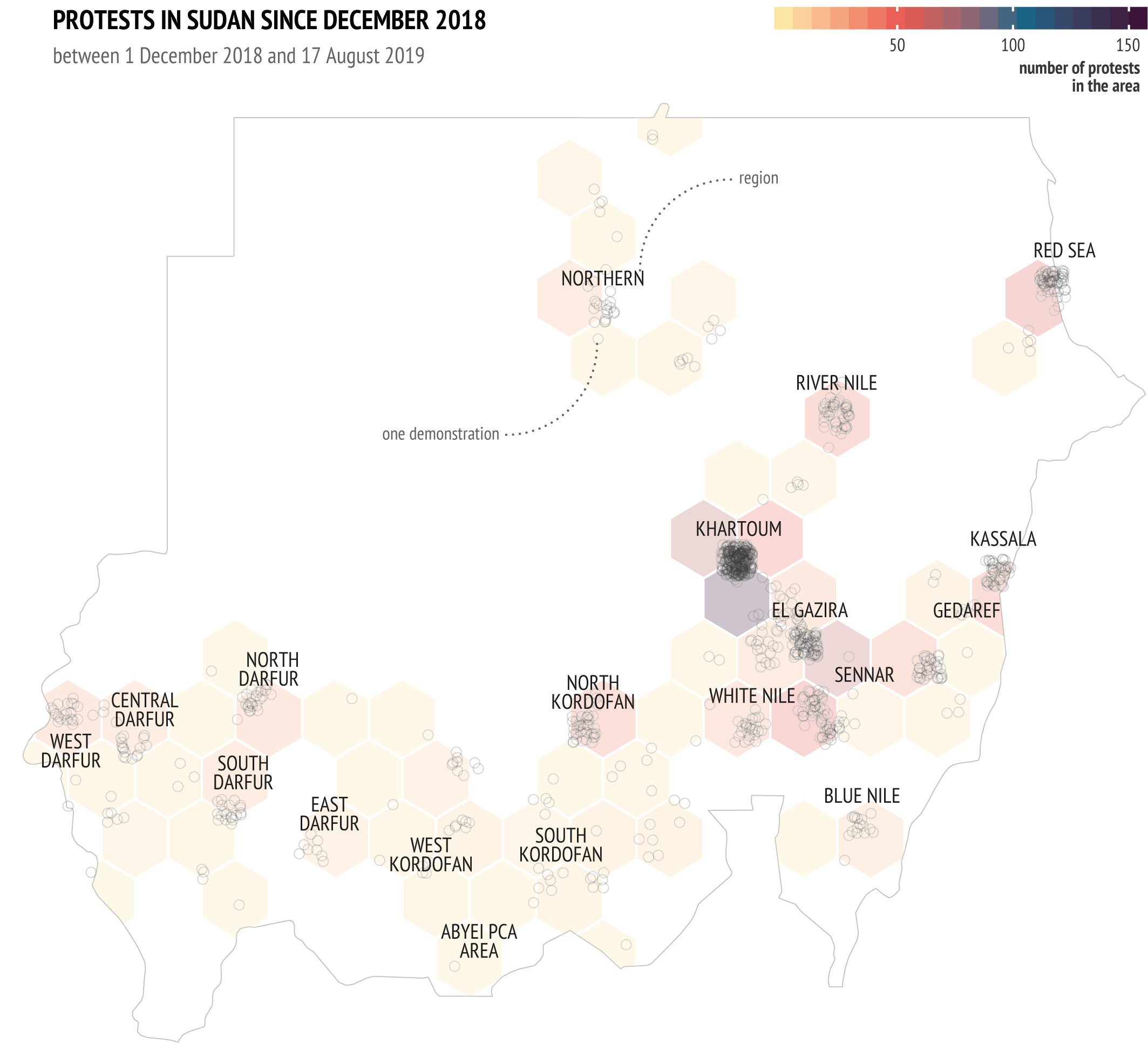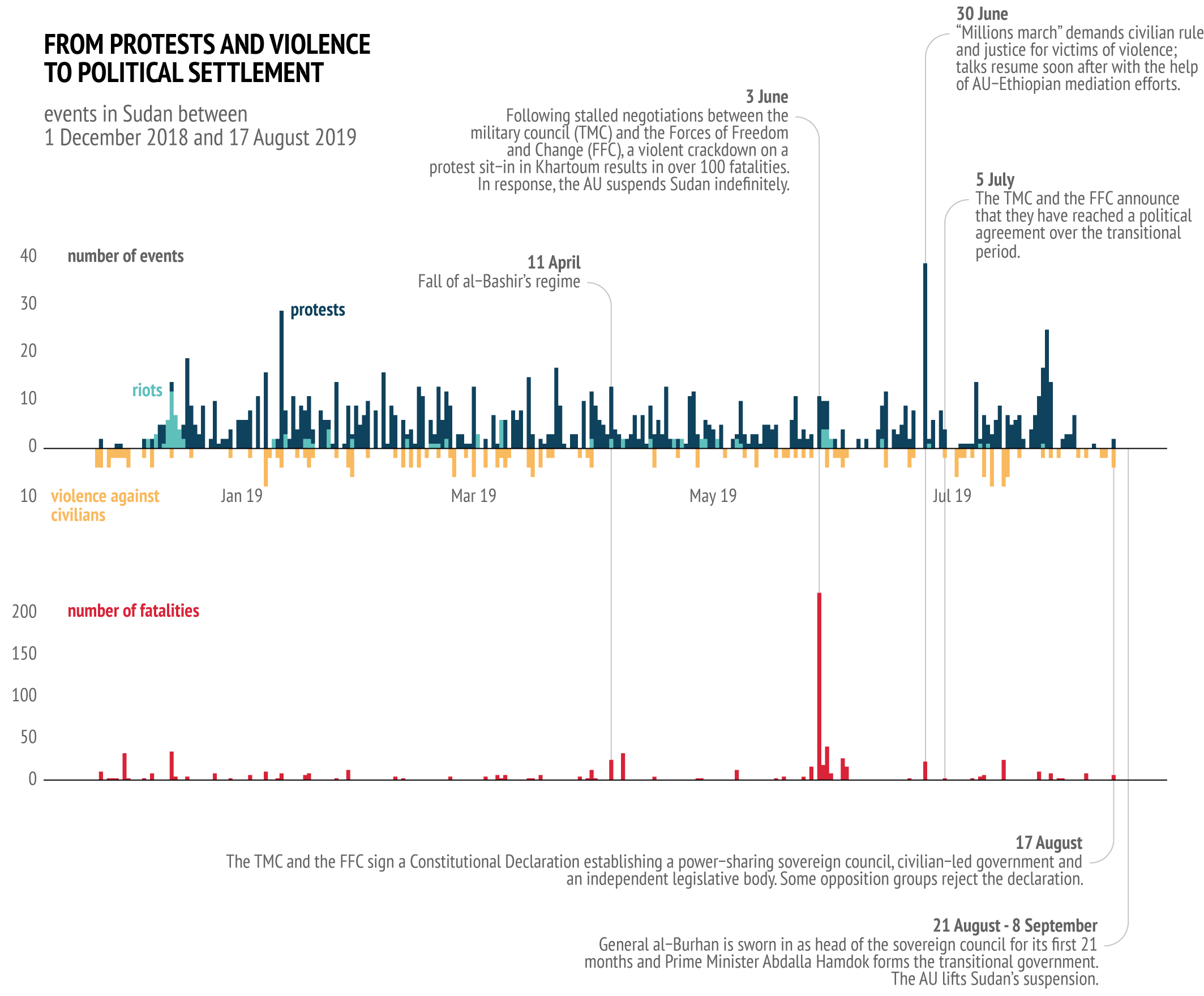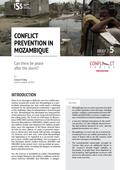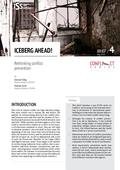You are here

Three scenarios for Sudan
Introduction
On 11 April, Sudan’s long-standing head of state, President al-Bashir, was removed from office by his military generals following a large-scale non-violent uprising against the regime. Four months later, on 17 August, the Transitional Military Council (TMC) and the opposition coalition Forces of Freedom and Change (FFC) signed a power-sharing agreement establishing a three-year transitional regime set up to steer the country towards democratic elections. The agreement forged in August was underpinned by the same dynamics that led to the overthrow of the regime in April: determined non-violent resistance demanding a transition to civilian-led rule.
These events in Sudan demonstrate the potential of strategic non-violence in bringing about societal change, even in the face of violent repression. Indeed, research has found that non-violent resistance, defined as ‘the application of unarmed civilian power using non-violent methods such as protests, strikes, boycotts, and demonstrations, without using or threatening physical harm against the opponent’, is not only increasingly frequent but also more effective in achieving its goals than violent rebellion.1 Moreover, recent studies show that non-violent resistance creates better foundations for building democratic institutions than armed or elite-led transitions.2 In the light of these research findings, there is genuine potential for democratic transition in Sudan.
Non-violent resistance induces transitions more conducive to societal peace and democracy than violent rebellions or top-down regime changes.
However, non-violent resistance does not automatically lead to a more participatory and peaceful society. Protest movements across the world – from Hong Kong to Algeria and Nicaragua – struggle to maintain their momentum and to evolve from revolution to lasting democratic reforms.3 Sudan’s own history demonstrates that reforming political institutions is a daunting task even when inspired by popular non-violent mobilisation.
This Conflict Series Brief analyses the recent civil resistance in Sudan, examines its distinctive characteristics and evaluates the prospects for a peaceful and stable transition in the country. It first examines why and how non-violent resistance increases the chances of peaceful societal change, and goes on to provide an analysis of the recent political events in Sudan, before outlining scenarios for the transition process and discussing ways to support stability.
Why non-violent resistance works
Compared to violent tactics, non-violent resistance seems to be an effective means of fighting one’s cause. According to a landmark study, contentious campaigns using primarily non-violent methods have been systematically more successful in achieving their goals and contributing to the emergence of a peaceful society than campaigns using armed tactics.4 In fact, according to the study non-violent campaigns are twice as likely to succeed – with a success rate of over 50% – as violent rebellions. The general picture remains similar in recent studies: on average, non-violent resistance induces transitions more conducive to societal peace and democracy than violent rebellions or top-down regime changes.5

Data: SCAD, 2018
A prerequisite for a successful non-violent campaign is the involvement of a high number of participants. Taking part in a non-violent campaign is often psychologically, physically, and technically easier than participating in an armed rebellion.6 This means that non-violent campaigns tend to attract larger numbers of people than violent campaigns, as well as a more diverse range of constituencies. By mobilising large crowds non-violent campaigns draw attention to the popularity of their cause, disrupt the modus operandi of their opponent, and pressure the ruling regime to make concessions.
Relatedly, non-violent campaigns are more likely to generate a political ‘jiu-jitsu effect’ whereby repression backfires and leads to increased mobilisation and political support for the opposition.7 Using coercive force against unarmed protesters runs the risk of creating a backlash even in an autocratic setting; it can induce domestic and international condemnation of the regime and lead to the regime being shunned by its key supporters. The relationship between a country’s armed forces and the opposition movement is particularly crucial. For the military, a non-violent opposition poses less of an existential threat than a violent rebellion and therefore it can be seen as a possible bargaining partner.8 Orders to violently suppress unarmed resistance may lead to defections within the armed forces, which often shapes the outcome of non-violent uprisings.
Brutal violence against protesters led to widespread international condemnation of the military council, while failing to suppress the civil resistance.
The events in Sudan reflect these dynamics. As with many other non-violent uprisings in recent years, the campaign started off locally, in the north-eastern town of Atbara, and was triggered by people’s immediate economic grievances sparked by rises in the prices of bread and fuel.9 However, protests quickly spread nationwide and became aimed at ousting President al-Bashir. The civil resistance – with protests taking place in at least 70 locations and mobilising hundreds of thousands of people – gained considerable international attention, not least due to the leading role that women played in the movement.10 Despite being met with violent repression, the protests managed to sustain their momentum during the early months of 2019. As expected, the defection of the armed forces proved decisive: by mid-April, the army had turned its back on al-Bashir and placed him under arrest. Political jiu-jitsu was seen again in June in the stand-off between the TMC and the FFC, as brutal violence against protesters led to widespread international condemnation of the military council, while failing to suppress the civil resistance.
Indeed, unlike in 2013, when violent repression ultimately succeeded in undermining the anti-regime protests,11 the Sudanese civil movement of 2018-19 managed to maintain its momentum throughout the various stages of the uprising. The civil movement first demonstrated its resilience in the aftermath of the removal of al-Bashir when it remained steadfast in demanding a transition to civilian-led rule. Even when brutal violence was unleashed against protesters – with more than 100 civilians killed and many more injured at the beginning of June –the civil resistance movement did not lose its grip.12 Finally, the civil resistance successfully staged a mass rally, dubbed the ‘millions march’, in late June,13 demonstrating the resolve of the protestors not only to the TMC but also to the relevant external stakeholders.
Strengths of the civil resistance movement
Two interrelated factors in the civil resistance movement contributed to its resilience and subsequent effectiveness: its level of organisation and its capacity to adapt tactics. Non-violent uprisings are sometimes (erroneously) seen as purely spontaneous and unorganised acts of street power. In reality, protest movements often build on and establish campaign infrastructures to facilitate their resistance activities.14 In Sudan, local protests quickly evolved into a well-organised civil movement with infrastructure for coordination and communication. The spearheading role assumed by the Sudanese Professionals Association (SPA) – an umbrella organisation for professional associations established in 2016 – and formation of the broad opposition coalition through the Declaration for Freedom and Change in January 2019 gave the resistance both depth and scope.15 Notably, this level of organisation differentiates the movement from that of the 2013 protests which were more loosely organised.
Specifically, the fact that the movement was so well-organised facilitated coordination of the multiple opposition groups and communication with both the regime and third parties. During the protests the SPA’s role in circulating information about resistance activities meant that the movement was able to sustain its momentum and regularly stage demonstrations and rallies against the authorities, an aspect found to be crucial for non-violent resistance.16 It was also important in countering the regime’s efforts to manipulate and de-legitimise the movement; the SPA responded swiftly to statements questioning the opposition coalition’s unity, peacefulness, or aims.17 The movement’s organised structure proved vital in the talks concerning the transitional rule too, as it helped the regime and the mediators identify counterparts on the civil resistance side that – while not directly representing various opposition groups – enjoyed credibility as representatives of the coalition.
Linked to this, the non-violent campaign in Sudan has managed to attract support across wide segments of society – not only in terms of drawing large numbers of demonstrators but also pooling these from different societal groups. The participation of politically marginalised groups, e.g. women and ethnic groups suffering discrimination in Darfur, was particularly visible during the first phase of the uprising. The slogan ‘We are all Darfur!’ chanted by demonstrators in Khartoum signalled the extent to which the civil resistance movement had galvanised support across different levels of society.18 This ability to mobilise a broad spectrum of citizens demanding political change contributed to the strength and appeal of the civil movement. It also made it difficult for the regime to dismiss the civil resistance as extremist agitators and to marginalise the protestors.19 This differentiates the Sudanese crisis from some other recent non-violent campaigns, most infamously in Syria, where the regime was able to portray the opposition movement as a Sunni insurrection and scare off minority groups from participating en masse in the non-violent uprising.20
The Sudanese civil resistance has demonstrated remarkable discipline in its commitment to non-violent tactics as well as creativity in the use of these.
Relatedly, the Sudanese civil resistance has demonstrated remarkable discipline in its commitment to non-violent tactics as well as creativity in the use of these. Commitment to non-violence plays an important role in the battle over the meaning and legitimacy of a non-violent uprising. Adapting non-violent tactics can also help demonstrators to counter state repression. In Sudan, after the brutal crackdown on protesters on 3 June forced the civil resistance to abandon the high-profile sit-in, the SPA called for a general strike instead and neighbourhood committees took a more active role in coordinating resistance activities. Moreover, the movement responded to the internet blackout imposed by the government by resorting to alternative means of communication, such as text messages and phone calls.21
Apart from these factors, strained relations among regime elites worked in favour of the non-violent movement. The coalition of Islamists and Arab nationalists that al-Bashir relied upon had started to fracture already in the late 1990s, and the rampant corruption that characterised his military rule and violent oppression of the earlier 2013 protests accelerated this process.22 As the non-violent resistance campaign gained impetus, al-Bashir came to be increasingly regarded as a liability that needed to be removed, even among his own patronage networks.
Main challenges facing the civil resistance
While organising a cross-cutting coalition has been a key strength of the civil resistance in Sudan, maintaining a united front – given the diverse range of opposition groups and constituencies – presents an increasing challenge. In particular, there is friction between the armed rebel movements and the FFC leadership, caused by diverging priorities concerning the emerging political order in Sudan. Put simply, while the protestors based in urban areas strive to establish civil rights-based rule, constituents (and opposition movements) residing in the conflict zones in Darfur and the Two Areas (Blue Nile and Kordofan) prioritise achieving peace and security and ending regional marginalisation.23 The Sudanese Revolutionary Front (SRF) – a coalition of Sudanese armed groups – rejected the constitutional declaration agreed in August on the basis that it inadequately addresses the question of peace.24 The cleavage between the centre and the periphery in particular and divisions among the opposition groups more broadly will present a major challenge in the Sudanese transition.25

Data: ACLED, 2019
Sudan’s military apparatus is another source of discord. In addition to the regular armed forces (RAF), al-Bashir’s regime relied on the National Intelligence and Security Services (NISS) and the Rapid Support Forces (RSF), a feared paramilitary group that has roots in the Janjaweed militia in Darfur and that is held to be responsible for much of the violence against civilians during and after al-Bashir’s rule. The fragmentation of the military apparatus originates from al-Bashir’s efforts to prevent coups by playing a game of ‘divide and rule’ among the different factions of his patronage networks.26 While this strategy helped al-Bashir to stay in power (until last April), it has since increased the risk of political instability and armed escalation.
In particular, the fragmentation of the military elites adds to the number of potential armed spoilers of the transitional framework. The RSF – led by General Mohamed Hamdan ‘Hemeti’ Dagalo – is in a particularly precarious position with regard to the transition, as its involvement in the transitional bodies is difficult to swallow for many in the opposition; however, its powerful position in the Sudanese political pyramid makes it hard to challenge.27 The constitutional declaration shows an effort to simultaneously control the military by placing the RSF under the authority of the RAF, provide justice by calling for an investigation into the violence that occurred on 3 June, and commit all security forces to the agreement by keeping them empowered and affording them some degree of immunity from prosecution.28
The violent repression that has been meted out to the Sudanese civil resistance is unfortunately not unique to Sudan. Violent coercion is frequently used to deter future mobilisation by instilling fear in the civil resisters and their supporters. Support from powerful international allies can make it easier for governments to use violence against civil resistance by lowering the costs of its repercussions.29 Furthermore, as non-violent protesters adapt their tactics to counter repression, governments develop their own means of undermining resistance. Blocking access to the internet has become a classic tactic designed to impede communication flow and hinder mobilisation. 25 governments used internet shutdowns in 2018, often in conjunction with other (violent) repressive tactics.30 The military council in Sudan blocked access to the internet for several weeks following the violent crackdown on the sit-in in June. However, much like violent repression, imposing internet blackouts can backfire by infuriating the general public and rendering the opposition even more resolute.
Three scenarios: military backlash, escalating violence or democratisation
The struggle of the campaign for ‘freedom and change’ in Sudan reflects a more general challenge present in civil resistance-led transitions: it is one thing to topple an undemocratic leader, another to achieve lasting change in the institutions underpinning a regime. Given the aspects identified here, some inferences may be drawn on how the situation in Sudan might evolve.
Despite the optimism generated by the agreed framework for democratic transition, an authoritarian backlash and consolidation of military rule remains a real possibility. This is due to several factors. First and foremost, Sudan has a history of such backsliding: both past successful non-violent uprisings in 1964 and 1985 were followed by a military takeover after a few years of unstable multi-party rule.31 The legacy of military-autocratic rule is unlikely to disappear overnight in Sudan; the generals are accustomed to exercise considerable powers and see themselves as essential for political stability. A transition to civilian rule would weaken their powers and possibly expose them to retribution for their past actions.
Relatedly, in comparison to the generals, the opposition leadership is inexperienced in ruling the state, yet it faces huge expectations in transforming the country’s political institutions and socio-economic structures. Managing these expectations will be difficult, and any social unrest or political instability that follows can contribute to an authoritarian backslide. The increased fragmentation of the opposition coalition renders stable civilian rule even more challenging. If the military generals manage to prevent infighting and the civilian coalition becomes more fragmented, the military leadership could use its privileged position (Lt. Gen. al Burhan having been appointed head of the sovereign council for the first 21 months) to consolidate its powers.
On the other hand, a renewed military backlash during the transitional period would be unlikely to produce a stable militarist regime in the long term. The Sudanese civil resistance, as discussed, has shown considerable resilience, appearing to have been better prepared for a military takeover than previous Sudanese uprisings or many other protest movements in recent years. For example, in comparison to their counterparts in Egypt in 2011, the Sudanese civil resisters managed to assert their relevance alongside the pre-existing party and military elites, thus securing more ownership in the transitional process.31 The established organisation and communication channels within the opposition can help resolve disputes and counter a military backlash. Moreover, the fragmentation of the security forces (another key difference to Egypt) makes it harder for strong military leadership to emerge. Were any military faction to pursue consolidation of power, opposition both within and outside the military elites would likely generate instabilities (e.g. coup attempts). In this case, rather than leading to consolidated authoritarian rule, attempts to hold on to military rule would more likely produce unstable regimes and renewed non-violent or violent mobilisation.

Data: ACLED, 2019
The situation in Sudan has some of the key conditions known to increase the risk of armed conflict: the country has a history of armed violence and it is undergoing a transition from an authoritarian to a more open political system.33 Aside from the fact that the country is facing a politically uncertain situation, Sudan’s economic crisis – which sparked the civil uprising – does not help alleviate the risk of conflict. Armed escalation might occur under two sets of circumstances. An unwillingness or inability to stick to the transitional deal might induce a coup attempt, which could escalate into an armed confrontation between the different armed factions. Alternatively, an attempt by the armed forces to reinforce their grip on power could spark a renewed civil uprising and lead to mutiny and defections within the security forces. In the event that such defections would only occur partially – leaving significant parts of the security forces standing – the outcome could be a full-scale armed insurrection against the regime.
While a civil war would be devastating for Sudan – worsening the humanitarian situation and inflicting further damage on the already catastrophic economy – the odds of such an outcome have considerably diminished since the power-sharing agreement was reached. An important aspect in this regard is international and regional support towards the constitutional declaration. This includes the military council’s allies in the Gulf who appear to have recalculated their strategies under international pressure and after growing fearful of the prospects of a protracted conflict. An escalated conflict in Sudan would have serious regional repercussions both in the immediate neighbourhood and in the context of the Gulf crisis, for example by jeopardising the continued participation of the RSF in Saudi Arabia’s armed intervention in Yemen.34 The threat of conflict escalation and the quest for stability appears to have led all major powers (at least for now) to rally behind the reached accords.
The threat of conflict escalation and the quest for stability appears to have led all major powers (at least for now) to rally behind the reached accords.
Although international pressure may help reduce the likelihood of a full-scale civil war, escalation of the regional conflicts presents a considerable risk. While the international spotlight has been on Khartoum, the conflict zones – especially Darfur – have witnessed a worrying upsurge in violence against civilians. This development and local actors’ disappointment at the way the constitutional declaration addresses the conflict situations puts the armed groups at odds with the emerging regime. While the reached agreement over the peace roadmap is a promising sign, frustration at the lack of progress in the peace processes – particularly if attacks on civilians continue – risks exacerbating tensions and leading to an escalation of violence in the conflict zones.
Against the backdrop of political stalemate and violence against protesters, it is perhaps surprising to find that some form of democratic transition is a more likely scenario than armed escalation or consolidation of military rule. The improved odds for gradual democratic transition are largely due to the organised, pluralistic civil resistance movement that has put constant pressure on the regime but also showed ability to negotiate. This was significantly facilitated by the mediation efforts of the African Union (AU) and Ethiopia. Indeed, the events in Sudan demonstrate the necessity for revolution to co-exist with conflict resolution: lasting societal change requires the capacity to negotiate and compromise.
A key factor in determining the outcome of the transition process will be the ability of the diverse Sudanese civic groups to continue building political consensus amid various competing interests and priorities. Sudan should benefit in this regard from the highly-organised nature of the civil resistance movement that has established communication channels and fostered a culture of participatory politics. However, the disputes within the opposition coalition concerning the composition and priorities of the transitional government are indicative of the challenges ahead in building a legitimate and inclusive government.
Another important aspect is the three-year timeframe established for the transitional regime. Elections are key manifestations of democratisation, yet they can also be manipulated to polarise societies and grab political power unilaterally. In order for the constituents to have free and equal voting opportunities, the political forces aiming to compete in the transformed political arena need time to prepare, while it will also take time to overhaul the country’s electoral institutions and procedures (e.g voting rules, constituencies, counting systems). Rushing to elections could jeopardise the emergence of a pluralist political system.
There are several serious challenges that can endanger the transition process. The dire state of the economy will not be fixed overnight and will continue to fuel grievances against the state if corruption and highly unequal wealth distribution are not institutionally addressed. Linked to this, the sectarian and tribalist patronage networks that the regime relied upon have accumulated wealth and can try to impede democratisation by buying off the opposition. Furthermore, Sudan’s ongoing internal conflicts can destabilise the state and spoil the transition by undermining the civilian-led authority. In addition to domestic challenges, international and regional powers can use their leverage to incentivise key Sudanese actors to either uphold the agreement or to sabotage it.
How to get there?
Given the competing interests of the multiple armed and unarmed actors, a key challenge facing Sudan is ensuring the commitment of the relevant actors in the transitional framework while building trust between different societal groups. In essence, this requires careful balancing between political realism and compromises on the one hand and commitment to the necessary reforms on the other hand. The following elements can support the transition and strengthen the resilience of Sudanese society.
Third-party guarantees can strengthen a power-sharing agreement by monitoring its implementation, with external stakeholders stepping in to facilitate talks or apply pressure when necessary. In the case of Sudan, the mediation role of the AU would naturally qualify it to provide such guarantees, with other international and regional actors backing the AU and refraining from supporting any parallel processes contradicting the framework.
Economic reforms and support. Improving the socio-economic situation of the population (by reforming public sector financing and spending) can reduce the prospects of anti-regime mobilisation. The military generals, many of whom benefited financially from the al-Bashir regime, will need to have incentives to support the (economic) transition. This might mean guarantees from the civilian authorities and financiers for sustaining a strong security apparatus. Simultaneously, international actors could coordinate to make the financial support contingent on consolidation of a civilian-led executive.
Addressing peace and security. As the mediation efforts to end the armed conflict(s) in Yemen demonstrate, a peace process that does not address all relevant groups risks ineffective deals and spoiling behaviour.35 For this reason it is important that achieving peace in the conflict zones is prioritised as agreed. In due time, concrete international support for SSR and DDR measures can help to sustain civil peace. In the short term, the international community might consider further renewing the mandate of the United Nations-African Union Mission in Darfur (UNAMID), until a transitional government is operational and the security situation has improved.
Accountability. Implementation of the mandated independent investigation into the atrocities committed against civilians on 3 June presents an important test of the transitional regime’s accountability. A failure to investigate and address the violence would risk alienating the population and setting a dangerous example of impunity in the wider region.
Electoral support will be essential in ensuring that the gains of the transition are not lost in electoral manipulation and/or violent escalation. International support could go beyond observing the elections and include identification of likely hotspots for violent escalation and the prevention of violence both before and after the elections. For example, local peace committees can help to facilitate non-violent dispute resolution and prevent cycles of polarising rhetoric and incitements to violence.
Finally, participation of the civilian actors behind the non-violent revolution – the networks of Sudanese women, men, and youth from different regions and backgrounds – is essential for the survival of the democratic transition. Supporting an inclusive process is not only ‘the right thing to do’ but also represents a pragmatic approach to the situation. After all, it is the resilience of these civil forces that has enabled the move from revolution towards reforms – and the impressive organisational and tactical skills that have characterised the civil resistance movement augur well for the future of democratic endeavours in the country.
References
1) Erica Chenoweth and Kathleen Gallagher Cunningham, “Understanding Non-violent Resistance: An Introduction”, Journal of Peace Research, vol. 50, no. 3 (2013), pp. 271-276.
2) Felix Bethke and Jonathan Pinckney, “Non-violent Resistance and the Quality of Democracy”, Conflict Management and Peace Science, 2019, pp.1-21; Markus Bayer, Felix S. Bethke and Daniel Lambach, “The Democratic Dividend of Non-violent Resistance”, Journal of Peace Research, vol. 53, no. 6 (2016), pp.758-771; Felix Bethke, “Nonviolent Resistance and Peaceful Turnover of Power”, Peace Economics, Peace Science & Public Policy, vol. 23, no. 4 (2017),pp. 1-5.
3) Freedom House, “Democracy in Retreat: Freedom in the World 2019”, 2019, https://freedomhouse.org/sites/default/files/Feb2019_FH_FITW_2019_Report_ForWeb-compressed.pdf.
4) Erica Chenoweth and Maria Stephan, Why Civil Resistance Works: The Strategic Logic of Nonviolent Conflict (New York: Columbia University Press, 2011).
5) See Bayer et al., “The Democratic Dividend of Non-violent Resistance”; Bethke, “Nonviolent Resistance and Peaceful Turnover of Power”; Mauricio Rivera Celestino and Kristian Skrede Gleditsch, “Fresh Carnations or All Thorn, No Rose? Nonviolent Campaigns and Transitions in Autocracies”, Journal of Peace Research, vol. 40, no. 3 (2013), pp.385-400.
6) Charles Butcher and Isak Svensson, “Manufacturing Dissent: Modernization and the Onset of Major Nonviolent Resistance Campaigns”, Journal of Conflict Resolution, vol. 60, no. 2 (2016), pp.311-339.
7) Jonathan Sutton, Charles Butcher, and Isak Svensson, “Explaining Political Jiu-jitsu: Institution-building and the Outcomes of Regime Violence against Unarmed Protests”, Journal of Peace Research, vol. 51, no. 5 (2014), pp. 559-573.
8) Phillip M. Lutscher, “The More Fragmented the Better – The Impact of Armed Forces Structure on Defection During Non-violent Popular Uprisings”, International Interactions, vol. 42, no. 2 (2016).
9) International Institute for Strategic Studies (IISS), “The Protests in Sudan”, January 2019, https://www.iiss.org/publications/strategic-comments/2019/the-protests-in-sudan.
10) Hilary Matfess, “Pressure Points: Sudan’s State of Emergency and Anti-government Demonstrations”, Armed Conflict Location and Event Data Project (ACLED), 2019, https://www.acleddata.com/2019/02/28/pressure-points-sudans-state-of-emergency-and-anti-government-demonstrations/.
11) Benjamin R. Naimark-Rowse, “Surviving Success: Nonviolent Rebellion in Sudan”, Journal of Peacebuilding and Development, vol. 12, no. 3 (2017), pp. 117-123.
12) Declan Walsh, “Sudan’s Protesters Call Off Strike and Agree to Resume Talks With Military”, The New York Times, June 11, 2019, https://www.nytimes.com/2019/06/11/world/africa/sudan-military-protester-talks.html; Tom Wilson, “Sudan Internet Blackout Forces Battered Protesters to Rethink”, Financial Times, June 11, 2019, https://www.ft.com/content/b1848126-8c0f-11e9-a1c1-51bf8f989972.
13) “Protesters are Back on the Streets in Sudan”, The Economist, July 6, 2019, https://www.economist.com/middle-east-and-africa/2019/07/06/protesters-are-back-on-the-streets-in-sudan.
14) Jonathan Sutton et al., “Explaining Political Jiu-jitsu: Institution-building and the Outcomes of Regime Violence against Unarmed Protests”.
15) See Sudanese Professionals Association (SPA), https://www.sudaneseprofessionals.org/en/about-us/, 2019.
16) Erica Chenoweth and Margherita Belgioioso, “The Physics of Dissent and the Effects of Movement Momentum”, Nature Human Behaviour, 2019, https://socialsciences.nature.com/users/269200-erica-chenoweth/posts/51786-the-physics-of-dissent.
17) Sudanese Professionals Association (SPA), “Forces of the Declaration of Freedom and Change – Statement”, June 15, 2019, https://www.sudaneseprofessionals.org/en/forces-of-the-declaration-of-freedom-and-change/.
18) Linda Bishai and Azaz Elshami, ”’We are all Darfur!’ – Sudan’s Unity Protests Stand a Real Chance: Time for the West to Step Up”, Just Security, January 2019, https://www.justsecurity.org/62404/we-darfur-sudans-unity-protests-stand-real-chance-time-west-step-up/.
19) Ibid; Flora Carmichael and Owen Pinnell, “How Fake News from Sudan’s Regime Backfired”, BBC News, April 25, 2019, https://www.bbc.com/news/blogs-trending-47899076.
20) International Crisis Group (ICG), “Syria’s Kurds: A Struggle Within a Struggle”, Middle East Report, 2013, no. 136; Zeina Karam, “No Fans of Assad, Syria’s Kurds Distrust Uprising”, Associated Press, April 18, 2012, https://news.yahoo.com/no-fans-assad-syrias-kurds-distrust-uprising-062508466.html.
21) Wilson, “Sudan Internet Blackout Forces Battered Protesters to Rethink”.
22) International Institute for Strategic Studies (IISS), “The Protests in Sudan”.
23) Dame Rosalind Marsden, “Can Sudan Achieve Peace and Democratic Transition?”, Chatham House, August 9, 2019, https://www.chathamhouse.org/expert/comment/can-sudan-achieve-peace-and-democratic-transition.
24) Ibid.
25) See Jerome Tubiana, “How Darfur Became Sudan’s Kingmaker”, Foreign Policy, July 9, 2019, https://foreignpolicy.com/2019/07/09/how-darfur-became-sudans-kingmaker/.
26) See International Crisis Group, “Sudan: Stopping a Spiral into Civil War”, June 7, 2019, https://www.crisisgroup.org/africa/horn-africa/sudan/sudan-stopping-spiral-civil-war.
27) “Who are Sudan’s RSF and Their Commander Hemeti?”, Al Jazeera, June 6, 2019, https://www.aljazeera.com/news/2019/06/sudan-rsf-commander-hemeti-190605223433929.html.
28) Sudan Constitutional Declaration, August 2019, http://constitutionnet.org/vl/item/sudan-constitutional-declaration-august-2019. The declaration gives immunity to all members of the transitional bodies, which can be lifted by a simple majority decision in the Legislative Council.
29) Jakob Tolstrup, Michael Aagaard Seeberg, and Johanne Grondahl Glavind, “Signals of Support from Great Power Patrons and the Use of Repression During Nonviolent Protests”, Comparative Political Studies, vol. 52, no. 40, 2019, pp. 514-543.
30) “The Global Gag on Free Speech is Tightening”, The Economist, August 17, 2019, https://www.economist.com/international/2019/08/17/the-global-gag-on-free-speech-is-tightening?fsrc=scn/tw/te/bl/ed/theglobalgagonfreespeechistighteningthenewcensors.
31) Benjamin R. Naimark-Rowse, “Surviving Success: Nonviolent Rebellion in Sudan”, Journal of Peacebuilding and Development, vol. 12, no. 3 (2017), pp. 117-123.
32) Clarke, “What Algeria and Sudan Can Learn from Egypt: Lessons From a Failed Revolution”.
33) Håvard Hegre and Nicholas Sambani, “Sensitivity Analysis of Empirical Results on Civil War Onset”, Journal of Conflict Resolution, vol.50, no. 4, August 2006, pp. 508-535.
34) “What’s at Stake in Sudan’s Transition?”, Reuters, July 18, 2019, https://www.reuters.com/article/us-sudan-politics-explainer/whats-at-stake-in-sudans-transition-idUSKCN1UD289.
35) Júlia Palik and Siri Aas Rustad, “Mediation in the Yemeni Civil War – Actors, Outcomes, and Lessons Learned”, Conflict Trends 05/2019, Peace Research Institute in Oslo (PRIO).


